Odoo Essentials: Notes Management
Purpose
The purpose of this document is to give a clear overview of how to use the Notes application of Odoo 16 to boost your productivity, collaborate in real-time with colleagues, and create personal to-do lists, which will allow you to better manage tasks and projects as well as achieve your goals and objectives.
Process
To get started, navigate to the Notes application.
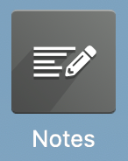
Notes Overview
On the first screen, you will see the following kanban view. Your view may look a bit different depending on your configuration.

The default columns for the app are New, Meeting Minutes, Notes, and Todo. You can customize these to reflect any desired goal by hovering over the column title. Click on the icon that appears to the right of the column title, then click EDIT STAGE.

Here you will be able configure the following fields:
Stage Name: This is where you will be able to edit the column name.
Folded by Default: This option, if enabled, will fold the column by default.
Click SAVE & CLOSE once you have finished making changes.

Create a Note
There are two methods to add a new note.
Option 1: Click the plus icon to the right of the column name to add a quick note. Simply enter the Title and click Add. You can also click EDIT to bring up the modal window covered in Option 2.

Option 2: Click the CREATE button to be presented with more comprehensive details, as shown in the example below.
Enter the details of your notes. To use formatting to style your message as desired (e.g. bold, italics, underline, etc), highlight the text to display a tool bar.

To gain access to other formatting options, typing / will display the available formatting options in a drop down menu, beginning with Heading Sizes and creating Paragraph blocks.

Bulleted List: This option allows you to create a bulleted list.
Numbered List: This option allows you to create a numbered list.
Checklist: This option allows you to insert a checkbox for checklists. Once you've placed the empty checkbox, you can click a box to show the item as completed.
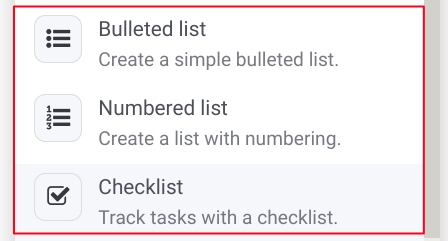
Separator: creates a line the width of the note to separate lines
Table: allows tables to be created within a note with a variety of widths and lengths for any additional data you'd like to include. When clicking this icon you'll be able to select a grid for the height and width of your table.
Note: that the size of your screen will affect the appearance of your table. If your screen is displaying on a mobile device, for example, your columns may be converted to rows for a mobile-friendly display.
Quote: will place a gray vertical line to the left of your line in the note to indicate a quotation.
/Code: This formatting will make your text display in a technical looking font.
- 2, 3 or 4 columns: Allows to create columns in a line, dividing it into 2, 3 or 4 columns.

Navigation
- Appointment: This option will allow you to create a new appointment type and enter a list of employees to be included in the appointment
- Calendar: This option will place a link to your companies calendar into your note.
Link: This option allows you to insert a web link into your Note, letting you share external information quickly and efficiently. To link text what you've already typed, highlight that text and click the Link. Otherwise you can simply click the Link icon where you'd like your link to appear.
Button: This option acts similar to a link, but surrounds your text in a colored block.
Medias
Image: This option allows you to input an image, document, or pictogram into your note.
Document: This is an easy way to add a document into the body of your note. It will create a clickable icon within the note that will download your document.
Pictogram: This option allows you to insert popular icons, like those you see within the body of our tutorial documents, like this star: .
- Video: This option allows you to insert embed code from your favorite video website into your note.
Article: The article option allows you to insert a button that directs you to the article related to the note.
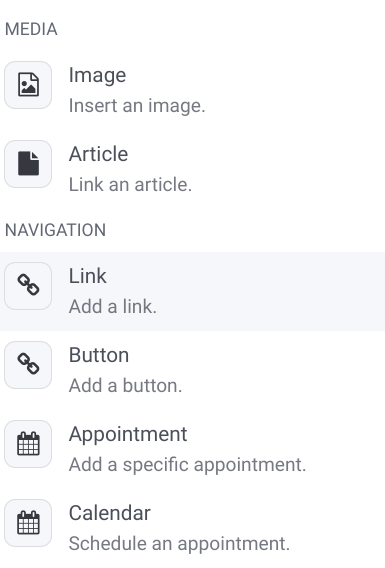
When adding a link, you will see the following modal window appear:
- Link Label: Define the appearance of the link view.
URL or Email: Define the email link or the URL to the webpage.
Type: By default, this will be set to link since you have selected the Link option.
Preview: This will give you a preview of the URL or Email, so you see how the link format will display in your Note.
Once you have finished configuring your link, click Save.

When the Image is clicked on, a modal window opens with the title, Select a Media. Here you can select different types of content to insert into the Note.
Image: You can upload an image from your computer, browse what's already been uploaded, or search royalty-free images using the Search an image field. When you've decided on an image, highlight it and click the ADD button to insert it into your Note.
Document: This is an easy way to add a document into the body of your note. It will create a clickable icon within the note that will download your document.
Pictogram: This option allows you to insert popular icons, like those you see within the body of our tutorial documents, like this star: .
- Video: This option allows you to insert embed code from your favorite video website into your note.
The Article option allows you to insert a button that directs you to the article related to the note.
Widgets
- 3 Stars: The option to create a 3 star rating on one line.
- 5 Stars: The option to create a 5 star rating on one line.
Basic Blocks
- Signature : The option to insert your signature in one line.
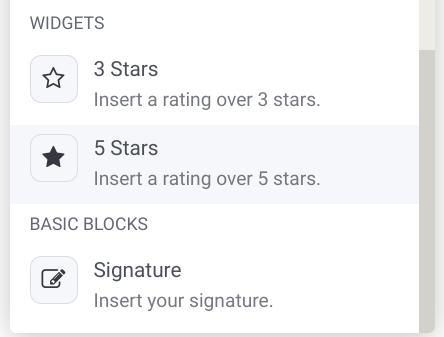
Tags
Tags allow you to customize the tags your team uses to sort and filter your notes. From the Tags field, you can start typing to view a drop-down menu. From that menu, you can select a tag that's already been created or you can select the CREATE AND EDIT function to create a new tag.

After clicking the Create and Edit link, the Create: Tags modal window will appear. In this window, enter the tag you'd like on the Tag Name line. Click Save when done, and you'll have it for future use.
Columns
By clicking on the Stage, you can create an additional column for your notes.

After clicking the icon, a text box will appear at the top of the new column allowing you to give it a title. Once you have created a title, click the ADD button to save the column and add it to your Notes screen.
In the event that a column was created or mistitled by mistake, you can hover your mouse cursor near the column title to make the settings wheel appear. Once the settings wheel is clicked on, you have the choice to select Fold, Edit Stage, or Delete from the sub-menu.
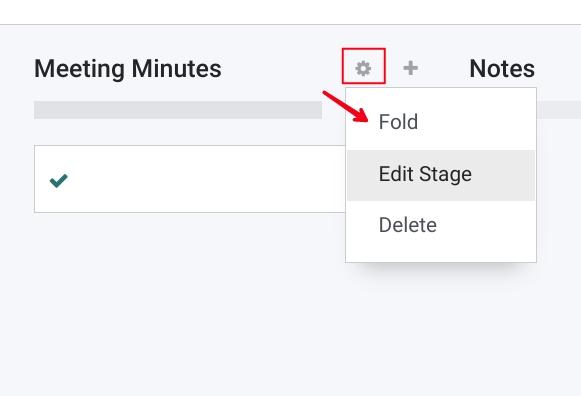
Folding a column condenses the affected column to a thin vertical bar. In the example below the "Meeting Minutes" column has been folded.
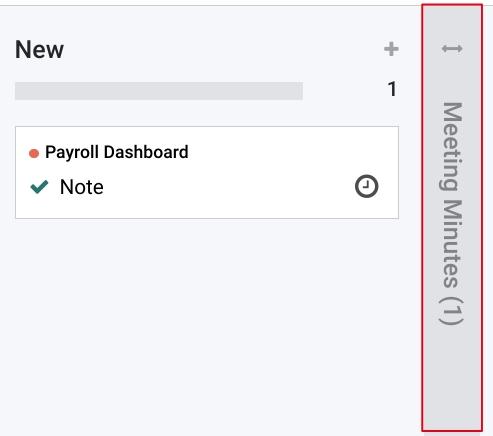
Good to Know!
There is no limit to how many columns you can create for Notes; however, keep in mind, the more columns you create, the harder it is to see all on one screen. The Fold feature is helpful when more than 6 columns are needed to manage tasks. Fold allows a column to be minimized within the Notes screen and kept for later viewing. When a column/task needs to be managed again, simply click on the Fold line of the task to expand it back to a full column.


